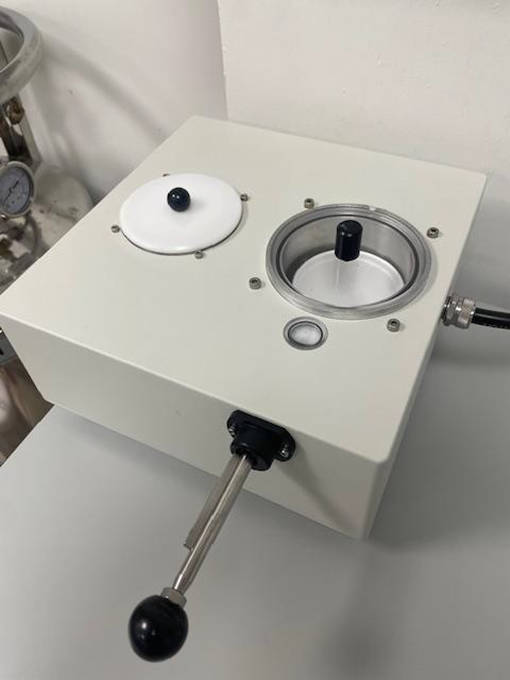Advanced Search
Cryopreservation
Last updated date: Nov 18, 2025 Views: 534 Forks: 0
Cryopreservation and sample preparation
Rationale: Samples need to be dehydrated before being embedded in a resin. However, classic dehydration techniques will result in the loss of DMSP from the cells. To effectively prevent the loss of DMSP from the cells, the entire sampling procedure leading to NanoSIMS analysis must be water-free, with all steps performed under strict anhydrous conditions. For this, we use cryopreservation techniques followed by freeze substitution in an acrolein-ether mixture. Freeze-substitution is the equivalent of dehydration, but at very low temperature. A solvent, here diethyl ether, progressively substitute the water molecules within cells at –90°C until the sample is fully infused with the solvent. At this temperature the water remains vitrified.
Material needed:
- Liquid nitrogen.
- Liquid nitrogen slush (a system allowing to place liquid nitrogen under vacuum, see Figure 1).
- Molecular sieve (activated by drying at >300 °C for a few hours, before being cooled and stored in a sealed or vacuum desiccator).
- Acrolein (with activated molecular sieve).
- Diethyl ether (with activated molecular sieve).
- Tetrahydrofuran (with activated molecular sieve).
- Freeze-substitution system (e.g., Leica EM AF2 freeze substitution unit).
- Cryovials fitting in the freeze-substitution system.
- Epoxy resin (e.g., Araldite 502).
- Oven at 60 °C.
Protocol: For the analysis of diffusible molecules, such as DMSP, all liquids (including resin components) and solvents must be anhydrous to prevent redistribution or loss of diffusible ions (this is typically achieved by adding activated molecular sieve to solutions. A substitution protocol suitable for retaining diffusible ions is provide in Table 1 (below). Samples must be rapidly frozen to limit ice crystal formation (which would impact their structure).
- Samples must be rapidly plunged into nitrogen slush (see Figure 1 below). If necessary, they can be stored in liquid nitrogen until freeze-substitution is performed.
- For freeze-substitution, frozen samples are transferred (without warming) to a cryovial containing 10 % acrolein in diethyl ether mixture with activated molecular sieve. The solution should be maintained at ≤ 120 °C in a bath of liquid nitrogen to avoid sample warming.
- Over the following 3 weeks, samples should be slowly warmed. As ice is not very soluble in ether, long substitution times are required.
- Once substitution is complete, bring the samples to room temperature and rinse in diethyl ether.
- Infiltrate with resin incrementally, with resin:ether mixtures starting at 1:2, then 2:1, and finally 100 % resin, for 1 h each.
- Mount samples in 100 % resin and cure as per resin requirements (60 °C for 36 h for Araldite 502).
- Samples should be stored in a desiccator to avoid absorption of water and possible movement of ions.
Table 1: Freeze-substitution protocol suitable for retaining diffusible ions when 10% acrolein in diethyl ether with molecular sieve is used as the substitution medium (from Kilburn and Clode 2013).
| Temperature (°C) | -100 | -90 | -70 | -20 | 0 |
| Time (h) | 24 | 168 | 336 | 24 | Hold |

Figure 1: Nitrogen slush can be generated by placing liquid nitrogen under vacuum (using either a common vacuum pump, a freeze drier, or a dedicated instrument (such as Vit-Master; Chun-Chia et al. 2005). Here part of a cryo transfer system (Alto 2500, GATAN) was used to place liquid nitrogen under vacuum. Once the nitrogen slush was formed, the vacuum was stopped, and the samples were quickly plunged into the slush.
References
Chun-Chia, et al. (2005) Successful pregnancy following blastocyst cryopreservation using super-cooling ultra-rapid vitrification. Human Reproduction 20.1: 122-128.
Kilburn MR, and PL Clode (2013) Elemental and isotopic imaging of biological samples using NanoSIMS. Electron Microscopy: Methods and Protocols. Totowa, NJ: Humana Press, 2013. 733- 755.
Related files
 NanoSIMS sample prep.pdf
NanoSIMS sample prep.pdf - Raina, J(2025). Cryopreservation. Bio-protocol Preprint. bio-protocol.org/prep2875.
- Raina, J., Clode, P. L., Cheong, S., Bougoure, J., Kilburn, M. R., Reeder, A., Forêt, S., Stat, M., Beltran, V., Thomas-Hall, P., Tapiolas, D., Motti, C. M., Gong, B., Pernice, M., Marjo, C. E., Seymour, J. R., Willis, B. L. and Bourne, D. G.(2017). Subcellular tracking reveals the location of dimethylsulfoniopropionate in microalgae and visualises its uptake by marine bacteria. eLife. DOI: 10.7554/eLife.23008
Do you have any questions about this protocol?
Post your question to gather feedback from the community. We will also invite the authors of this article to respond.
Share
Bluesky
X
Copy link
